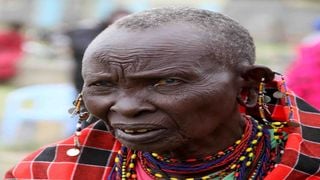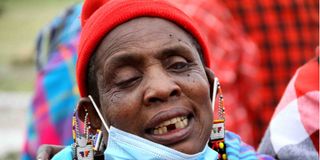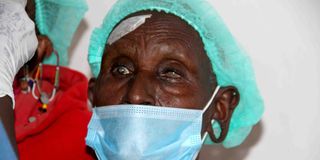
A resident of Narok West Sub-County who has been afflicted by visual impairment.
| George Sayagie | Nation Media GroupNarok
Premium
Experts probe reason for mass blindness in Narok village
What you need to know:
- Most locals interviewed by the Nation believe that the eye diseases are caused by the weather or are hereditary.
- Narok is one of the seven counties which have remained trachoma-endemic despite massive health campaigns.
Moitalel Njapit stands forlorn, supporting himself with one of his sticks as his cattle graze on the plains of Siana in Narok West Sub-County.
From far, he looks like he is peering at the horizon surveying his herd. You would be mistaken to think that his old age is the only limitation to his vivacity. At a closer look, one will realise that the septuagenarian has a visual impairment.
He was not born blind 72 years ago. He gradually lost his ability to see as he grew up and now, he can no longer see.
Further down the Lemek Plains, 14-year-old Agnes Nchoe, a Class Six pupil at Lemek Boarding School, gropes helplessly trying to discover who the other children playing nearby are.
Nchoe, who aspires to be a doctor when she completes her education, lost her visual ability in her right eye in 2009.
In this sub-county, the young and old have been afflicted by visual impairment, which they believe is caused by several factors.
And it is not only happening on the Kenyan side. Across the border where the Tanzanian territory begins, several people have also lost the ability to see.

One resident of Narok West Sub-County who has been afflicted by visual impairment.
Eye condition
One such person is Mr Kuyo Sarikoki from Kiritaru Village in Sengeti Division in Tanzania who, on the day we met him, had crossed into Kenya on a motorcycle to seek treatment at Oloolaimutia dispensary.
“I have been suffering from an eye condition that looks like an allergy for the last 20 years. I decided to cross over to the Kenya side to try my luck,” said Mr Kuyo.
Most locals interviewed by the Nation believe that the eye diseases are caused by the weather or are hereditary, but ophthalmologists attribute them to a breed of flies that is common in areas where there are many cows.
Trachoma, the specialists say, is common because cow dung from the hundreds of large cow herds and spilt milk is conducive for breeding of the flies.
Interestingly, in Ololaimutia, like in many other villages along the Kenya-Tanzania border, they believe that the more flies one attracted, the more wealth one accumulates. A myth that could be ruining lives.
In Narok County alone, at least 10,000 people are threatened by blindness because of eye illnesses among them trachoma, cataract and trauma of the eyes caused by external objects. A large percentage of the statistics is from the Narok West Sub-County.
A consultant ophthalmologist at Eldoret Referral Hospital, Dr Ernest Ollando, says dirt and flies cause trachoma because the bacterium called chlamydia trachomatous scars the membrane inside the eyelids, making the lashes turn inwards and rub the eyeball, causing a painful, blinding injury.
Dr Ollando says that factors that can lead to an increased risk of diseases include dirty faces in children who go for days without washing their faces due to water scarcity as well as poor sanitation, which attracts flies.
“Besides the cultural issues, the trachoma problem in Narok is further compounded by frequent prolonged droughts, which make water scarce,” said Dr Ollando.
Recent surveys show trachoma has been on the decline in Kenya and the rest of the developing world in the past 30 years, but Narok is one of the seven counties which have remained trachoma-endemic despite massive health campaigns.

One resident of Narok West Sub-County who has been afflicted by visual impairment.
Avoidable blindness
Others are Kajiado, Samburu, West Pokot, Turkana, Laikipia and Nyambene. An ancient disease now extinct in the developed world, trachoma remains the leading cause of avoidable blindness in developing countries.
“To fully appreciate the effects of trachoma, it must be seen as hampering health, education and development. This calls for concerted efforts in checking its spread,” says Dr Ollando.
Another common eye disease in the county is the cataract which affects people between the ages of 60-70 years and which Dr Ollando says doctors treat by doing a small incision cataract surgery.
Ministry of Health surveys on attitudes and practices relating to facial cleanliness and the improvement of environmental hygiene carried out in 88 manyattas in Narok found that a majority of children did not wash their faces, and those who did, shared towels, which spread the disease even further.
Sources from the Narok County Hospital indicate that this year alone, they had carried out 25 surgical operations in Loita division, Oloolaimutia, Talek and Aitong and areas around the Maasai Mara game reserve.
According to an eye doctor, Dr Leyian Sempele, working with Waso Resource Development Agency (Warda), they have come in to help this community with free eye surgeries and 2,500 have already been identified.
“There are several cases of traumatic cataracts, juvenile cataracts which we refer to hospitals in Narok or Nairobi,” said Mr Sempele.





